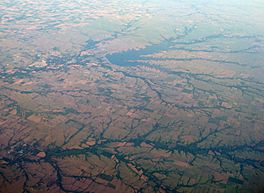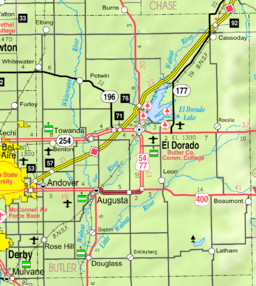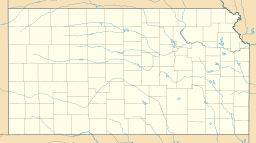El Dorado Lake facts for kids
Quick facts for kids El Dorado Lake |
|
|---|---|

Aerial photo of El Dorado Lake and vicinity, facing northwest (2011)
|
|

|
|
| Location | Butler County, Kansas |
| Coordinates | 37°50′50″N 96°49′23″W / 37.84722°N 96.82306°W |
| Type | Reservoir |
| Primary inflows | Walnut River |
| Primary outflows | Walnut River |
| Catchment area | 247 sq mi (640 km2) |
| Basin countries | United States |
| Managing agency | U.S. Army Corps of Engineers |
| Built | October 1973 |
| First flooded | June 1981 |
| Surface area | 8,000 acres (32 km2) |
| Average depth | 19 ft (5.8 m) |
| Max. depth | 60 ft (18 m) |
| Water volume | Full: 158,189 acre⋅ft (195,123,000 m3) Current (Nov. 2015): 150,702 acre⋅ft (185,888,000 m3) |
| Shore length1 | 98 miles (158 km) |
| Surface elevation | Full: 1,339 ft (408 m) Current (Nov. 2015): 1,338 ft (408 m) |
| Settlements | El Dorado |
| 1 Shore length is not a well-defined measure. | |
El Dorado Lake is a large, man-made lake in Kansas. It's located near the city of El Dorado. This lake was built on the Walnut River. The U.S. Army Corps of Engineers built and manages it. They use it to help control floods, for fun activities, and to provide water. You can also find El Dorado State Park right on its shores.
Contents
Building El Dorado Lake
The idea for El Dorado Lake came from the Flood Control Act of 1965. This law allowed the lake to be built. The U.S. Army Corps of Engineers started building in October 1973. The lake was ready to help with flood control by June 29, 1981.
How the Lake Was Formed
When El Dorado Lake was built, it covered two smaller lakes. These were Bluestem Lake and the original El Dorado Lake. The first El Dorado Lake was built in 1927. It provided water for the city of El Dorado. Bluestem Lake was built in the 1950s. The dams of both old lakes were broken down. Their waters then became part of the new, bigger El Dorado Lake. You can still see parts of Bluestem Lake's old dam today. They are in the Shady Creek area of the lake.
Where is El Dorado Lake?
El Dorado Lake is in south-central Kansas. It is located in the Flint Hills region. The entire lake is within Butler County. The lake sits at an elevation of about 1,335 feet (407 m).
Rivers and Streams
The lake is held back by the El Dorado Lake Dam at its southwest end. The Walnut River flows into the lake from the north. It also flows out of the lake to the southwest. Other smaller streams flow into the lake too. These include Gilmore Branch, Cole Creek, Durechen Creek, Satchel Creek, Bemis Creek, and Shady Creek.
Roads Around the Lake
Several roads run near El Dorado Lake. The Kansas Turnpike (Interstate 35) crosses the northern part of the lake. It then runs along the northwest shore. U.S. Route 77 is west of the lake. U.S. Route 54 is about 1.5 miles (2.4 km) south of the lake. Kansas Highway 177 crosses the eastern parts of the lake. Other local roads also go around the dam and the lake. The city of El Dorado is just southwest of the dam.
How Big is the Lake?
The size of El Dorado Lake changes. It depends on how much water flows in and the weather. The lake has different "pools" based on its water level. When the lake is full, it covers about 8,000 acres (32 km2). At this point, its surface is about 1,339 feet (408 m) high. It holds about 158,189 acre-feet (195,123,000 m3) of water. If the lake fills to its maximum capacity, it covers 10,700 acres (43 km2). Its surface would be 1,347.5 feet (410.7 m) high. It would hold about 240,660 acre-feet (296,850,000 m3) of water. The lowest part of the lake, the streambed, is at 1,271.5 feet (387.6 m).
How the Dam Works
The El Dorado Lake Dam is made of earth. It is about 99 feet (30 m) tall from the riverbed. The dam is very long, about 20,930 feet (6,380 m). The top of the dam is at 1,370.5 feet (417.7 m) high. There is a special overflow area called a spillway. It is 350-foot (110 m) wide and helps release extra water. There is also a large oval pipe, 11.5-foot (3.5 m) by 15.75-foot (4.80 m), for water to flow through. The dam can release a lot of water quickly, up to 41,200 cubic feet per second (1,170 m3/s).
Who Manages the Lake?
The U.S. Army Corps of Engineers manages the dam and the lake. They work with the Kansas Department of Wildlife, Parks and Tourism (KDWP). The KDWP manages about 4,000 acres (16 km2) of land around the lake. This land is part of El Dorado State Park. They also manage another 4,000 acres (16 km2) as the El Dorado Wildlife Area. The KDWP also takes care of boating on the lake and the fish living there.
Fun Things to Do at El Dorado Lake
El Dorado State Park is a great place to visit. It has four main areas around the lake. These are Bluestem Point, Boulder Bluff, Shady Creek, and Walnut River.
- Bluestem Point Area: This area is between the two eastern parts of the lake. It has boat ramps, camping, and hiking trails. You can also find a bait shop and a swimming beach here.
- Boulder Bluff Area: This area is along the western shore. It offers boat ramps, camping, and hiking trails.
- Shady Creek Area: This area is on the south shore of the lake's southeastern arm. It has boat ramps, camping, hiking trails, and a marina.
- Walnut River Area: This area is just southwest of the dam. It includes boat ramps, camping, hiking trails, an amphitheater, and a swimming pond.
You can go fishing for fun in El Dorado Lake. Hunting is also allowed in the El Dorado Wildlife Area. It is also permitted on 2,000 acres (8.1 km2) of land within El Dorado State Park.
Animals at El Dorado Lake
El Dorado Lake is home to many kinds of fish. These include blue and channel catfish, rainbow trout, walleye, white bass, white crappie, and wiper. There are also two species that are not native to the lake: the white perch and the zebra mussel.
Many animals live on the land around the lake. You might see beavers, bobcats, coyotes, and deer. There are also different birds like doves, pheasants, prairie chickens, quail, and turkeys. Other small animals include rabbits, raccoons, and squirrels.



